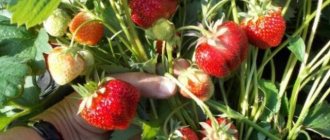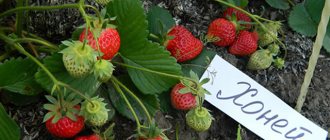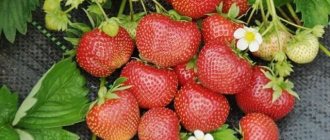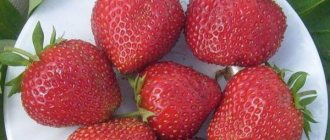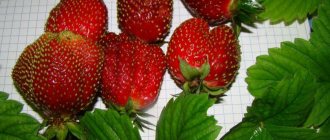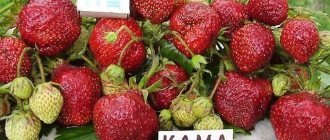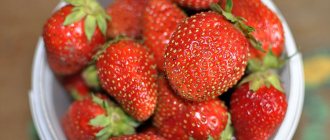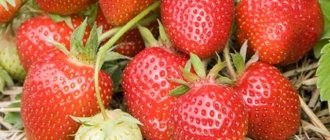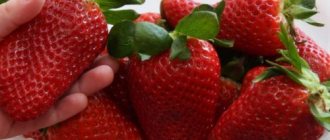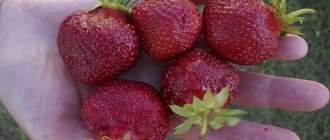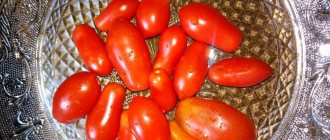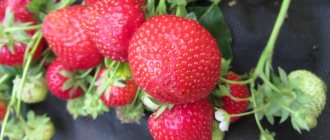Home / Care
Back
Published: 04/26/2020
Reading time: 10 min
0
12
- 1 Review: Seeds Aelita “Strawberry remontant large-fruited Coquette” - The growing process is very complicated. 1.1 "Yellow Miracle"
- 2.1 Update
Growing bare strawberries
The development of the plant and its fruiting directly depends on the method of propagation and care. In order to grow a healthy young bush, you should know that it is best to do this with seeds. You can grow coquette strawberries by dividing the bush, but this requires special skills and a lot of effort.
Planting of beardless strawberries should be carried out only in fertile and loose substrate. The soil should consist of humus, sand and peat. You can also use purchased soil to germinate seeds. If you decide to prepare the soil for planting yourself, then it must be heated for 20 minutes. This time will be enough for all kinds of larvae to die and not harm young plants.
In order for the seeds to be evenly distributed on the surface of the soil, they must first be mixed with sand.
Seeds should be sown in March or late February. It is recommended to soak the grains in water for 5 hours before use. This will significantly speed up seed growth. At the end of this time, remove the seed from the water and allow it to dry thoroughly.
Strawberries should be sown in small containers. An excellent option would be cups whose height does not exceed 5 cm. Before placing the grains in the soil, the soil should be watered generously. It is not worth deepening the seeds, as they germinate under the influence of sunlight. For quick germination, the containers should be covered with polyethylene and placed on the sunny side. It is best to grow remontant coquette strawberries at a temperature of about 240 C. The soil should be moistened with a spray bottle. If everything is done correctly, the first shoots will appear in 2 weeks.
If a common box was used for sowing seeds, then young plants must be picked.
The procedure should be carried out when 2-4 full leaves appear on the bushes. The transplant should be done using a knife or other available material.
When picking, special attention should be paid to deepening the bush. You should not make large dimples, as this can stop the development of the bush
It is recommended to water the transplanted strawberries using a pipette. Keep containers in partial shade for some time, away from direct sunlight.
In order for young bushes to harden, boxes with seedlings should be taken out into fresh air every day, gradually increasing the residence time.
Strawberries can be planted on the site 7 weeks after planting.
The land should be well cleared of weeds and various debris. The soil should be fertilized with compost and humus. It is best to apply them in the fall, when digging up the site. After planting, water the bushes well. In order for the plant to grow quickly and produce a good harvest, it is necessary to periodically loosen the soil and remove weeds.
Knowing the description of coquette strawberries and comparing them with other varieties, you can be convinced of the advantages of this type. By adhering to the basic planting rules, you can grow a healthy plant that will bear fruit several times a season.
Coquette strawberry harvest in September - video
Strawberries are considered one of the most commonly grown berries in summer cottages and garden plots. Caring for the crop is associated with difficulties in organizing space due to the long shoots of strawberries. Recently, summer residents have been giving preference to varieties of strawberries. They have high yields. This berry is great for eating fresh and preparing a variety of sweet desserts. Large-fruited strawberries are the most widespread in our country. In addition, when growing beardless varieties, there is no need for regular monitoring of the condition of the shoots. Breeders have developed many varieties of this popular berry. When choosing the most suitable ones for yourself, you can focus on the description of varietal characteristics. It wouldn’t hurt to familiarize yourself with a photo of the plant during the fruiting period in order to have at least a rough idea of the shape and size of the berries.
When choosing a particular variety, it is very important to take into account its zoning for your area. After all, not only the survival rate of the crop and the general development of the plant depend on this, but also the size of the berries, as well as the yield indicators of a particular variety in a given climatic zone
Today we will talk about varieties of large-fruited strawberries.
Tips for growing barless strawberries Coquette
Growing the strawberry variety Coquette by division is a very difficult task, so it will be easier and better to try to germinate the seeds.
The seed planting method will have a positive effect on the fertility and development of the bush. Since the seeds grow slowly, it is best to start planting in February-March. Before placing the seedlings in the ground, the seeds require preparation:
- You should soak the seeds first, this will speed up their growth. You need to take the Ecorin solution, dilute 5 drops of this solution in 50 ml of water, and place the seeds on gauze soaked in this material. This will keep the seeds well hydrated before planting. Leave for 5 hours.
- The next step is to take out the seeds and let them dry.
- Moisten the soil in the ground, only then can the seedlings be planted.
- Tweezers should be used to place the seeds into the ground.
- There is no need to bury deep or cover the seeds with soil; you need to apply gentle pressure so that the seed goes smoothly into the soil.
- Since the main assistant in the growth of strawberries is the sun, you should plant 1 seed per container, or keep a distance of one and a half, two centimeters.
- After planting the seeds, sprinkle the soil again with water and cover it with an object that would transmit light and create favorable conditions for the development of the seedling.
- The container with seeds must be kept in a warm place with a temperature of at least 24 degrees, the room must also be well lit.
- Every day, do not forget to maintain moisture in the pots and ventilate the container with the seeds.
- In just 10-14 days you will be pleased with the first sprouts of the Coquette strawberry.
Small-fruited beardless strawberries: choice for different regions
Varieties of garden strawberries with medium-sized berries have excellent taste. At the height of fruiting, fragrant berries shower the bushes, filling the air around with an incredible strawberry aroma.
"Alexandria"
Developed in the USA, it is known for its long-lasting fruit production.
On a note! Strawberries "Alexandria" are suitable for planting on ridges of open ground, as well as in pots, flowerpots for growing on a windowsill, on balconies and loggias.
Bushes with spreading flower stalks, tall and thin. The berries are conical, rich red in color with gloss, weigh 6-8 grams (for small-fruited varieties this is a lot of weight). The achenes are red, slightly depressed. There is a characteristic strawberry aroma. The approximate fruiting time is from early June to mid-October. 350-400 grams of berries are harvested from the plant per season.
"yellow miracle"
The yellow-golden berries of this strawberry look original against the background of green foliage. The variety is German, propagated by seeds or by dividing the bush, since there are no mustaches on the plant.
The berries are elongated, elliptical in shape, with golden achenes on the surface. They weigh no more than three grams. The taste is sweet, with a characteristic pineapple aftertaste and aroma. Since the fruits do not contain red pigment, they can be eaten even by allergy sufferers.
"Baron Solemacher"
A time-tested variety from Germany, it is famous for its excellent taste of berries with a bright strawberry aroma. Plants are small, well leafy. The leaves have serrated edges, light green with a silvery tint. Fruiting begins in the first year after planting, the highest yield is in 2-3 years. Transplantation – after 4 years.
The fruits are small, up to 3-4 grams in weight, bright red. They ripen in the middle zone in early June, bearing fruit until early September. In the southern regions, the last collections are in November.
"rügen"
Winter-hardy garden strawberries were bred many years ago in Germany. The bushes grow up to 18-20 cm, the peduncles are strong and erect. During the ripening period, the berries do not lie on the surface of the ground, they are always clean, and do not rot.
The fruits are small, up to 2.5-3 grams, scarlet-red in color. The tip of unripe berries is slightly whitish. The achenes are large and located on the surface. The taste is excellent, the flesh is dense and sugary.
Planting requires rejuvenation every three years. The variety is demanding on watering and soil fertility. With proper agricultural technology, it bears fruit until frost.
"Ali Baba"
These delicious garden strawberries are famous for their abundant harvests (up to 0.5-0.7 kg). The bushes are powerful and leafy. They bloom and bear fruit in the first season. During the flowering period, the plants are strewn with numerous white “caps” of inflorescences.
The berries are slightly elongated and resemble wild strawberries in shape. Weight – 6-8 grams, achenes are small. The skin color is bright red, the core is milky white with pink splashes. The bushes tolerate cold weather well and quickly adapt to different climatic conditions.
"Forest Tale"
According to reviews from those who grew this variety, it is very similar in taste and aroma to the berries of real wild strawberries. The name is one hundred percent justified. A medium-sized plant with tall peduncles and bright green foliage.
The fruits are dense, juicy, weighing no more than 6 grams. Color – red, shape – conical. The bushes bear fruit until autumn and do not form mustaches. Use - desserts, freezing, making jams.
"golden"
Golden bushes also do not form mustaches. This garden strawberry attracts with the unusual color of its fruits; they are creamy-yellow, weighing 9-11 grams. Plants reach 18-20 cm, the leaves are dark green, with teeth.
The berries are formed from June to mid-October. The taste is pleasant, sweet. Many summer residents note that small-fruited yellow-white varieties are superior in taste to their red-fruited “brothers.”
"ruyana"
Strawberries from Czech breeders, productive, easy to care for. The plants are compact, up to 18-20 cm high. Peduncles rise above the leaves, so the berries do not lie on the ground when ripe. The leaves are light green in color and shiny.
The first flowers appear at the end of May and continues until September. Fruiting is continuous, the berries are collected as they ripen throughout the summer season. The fruits are small, 5-7 grams, conical in shape. The dense berries taste sweet and aromatic. They are stored fresh without losing their presentation for 5-7 days.
By planting vineless garden strawberries on your plot, you can greatly simplify care while still getting a high yield of berries. You just need to remember about the mandatory rejuvenation of plantings and take care of obtaining crop seedlings in advance.
Beardless strawberry Rügen
The variety of German selection, with almost a hundred years of history, is famous for its high productivity. A neat bush with abundant foliage, hung with berries until October, often becomes a decoration of the local area, located in flower beds or along paths. It can grow indoors without requiring additional lighting sources.
The Rügen variety is adapted to the conditions of the Moscow region. The plant demonstrates good disease resistance. Its small bright red oblong berries with dense yellowish pulp inside exude the aroma of wild strawberries and have a sweet, pleasant taste.
Features of cultivation
Since the Garland strawberry produces a sufficient number of runners, it can be propagated not only by seeds, as is often done in the case of remontant varieties, but also by more conventional methods: dividing the bush and runners. All three methods have approximately the same frequency of use. The seed method is more labor-intensive, but the seedlings turn out healthy and the plantings are reliably renewed. When dividing a bush, which is very simple to do, the accumulated pathogens do not disappear anywhere.
Propagating strawberries with mustaches is the easiest way; it is important to take the mustaches from 2-3-year-old strong bushes after their natural rooting. The best rosettes are the first from the mother bush
They should be dug up with a clod of earth and immediately planted in a pre-prepared bed. When purchasing seedlings, you should give preference to the potted version.
The mustache should be allowed to take root well in the mother bed.
Seed propagation is also not as difficult as it seems: everyone who grows vegetable seedlings can handle strawberries. At the end of February - beginning of March, the seeds are sown without being buried in a box, at the end of March the seedlings are planted in individual cups, and at the end of April they are planted in a permanent place. Strawberry bushes Garland are located at least 30 cm from each other. The variety grows on almost any soil, but prefers sandy loams and loams with a slightly acidic reaction of the environment, and best of all, chernozems fertilized with wood ash.
Caring for plantings in a regular garden bed is no different from caring for other remontant varieties. In normal weather, strawberries are watered 1-2 times a week. If it rains, watering is not necessary, and in case of excessive moisture, the bed is even covered with film during the rainfall. They try to fertilize strawberries with organic compounds and ash. Before the start of flowering, strawberries most of all need nitrogen; during the period of intense flowering, potassium; and during fruiting, no fertilizing is applied. In the fall, in preparation for winter, humus and ash are added to the bed. They loosen the soil often, but very superficially; mulching helps fight weeds.
Normal fruiting begins in the summer following planting, with maximum yield occurring in early August. At the end of the season, all damaged leaves are cut off and snow retention measures are carried out. Strawberries overwinter well under the snow, but just in case, coniferous spruce branches are laid on the beds.
In cold regions, shelter will help before snow falls.
When growing strawberries in pots, you can use a separate container (half a bucket in volume) or long boxes for each bush, in which the bushes are planted every 25–30 cm
It is important to fill the containers with fertile soil (a 1:1 mixture of humus and turf soil is suitable) and do not forget to put drainage at the bottom. When growing in pots, care is somewhat different.
Thus, it requires almost no loosening of the soil, but you have to carefully monitor the soil moisture: both drying out and overwatering are detrimental to plants. You should also feed carefully, using infusions of mullein or wood ash. Excess tendrils that interfere with the aesthetics of the plants are cut off, and the rest are allowed to hang down, forming elegant cascades.
Disadvantages of existing varieties of garden strawberries.
— Most existing varieties of garden strawberries are not resistant enough to diseases and pests. — Peduncles, often lying down under the weight of berries, are located below the level of leaves. — The berries ripen over a relatively long period of time, are not equal in weight, and are unevenly colored. — The pulp of the berries is often poorly colored and not dense enough. — The fruit is difficult to separate from the fruit. — The fruits are often asymmetrical, comb-shaped, with an uneven, ribbed surface. — The skin of the berries is delicate and easily damaged when picking and caring for plants. — Not all varieties have a harmonious, full taste.
Basic economic properties.
Productivity: low (less than 6 t/ha); medium (6-9); above average (9-14); high (more than 14 t/ha). Taste: mediocre, satisfactory, good, very good, excellent. Aroma: none, weak, medium, strong. Pulp juiciness: low, medium, high. Direction of use: dessert, table, technical, universal.
Remontant strawberry
It is of particular interest to gardeners. Its main distinguishing feature is the ability to lay flower buds at high temperatures and long daylight hours. The harvest continues until late autumn. Two types of remontant strawberries are common in cultivation: small-fruited and large-fruited.
Currently, there are many varieties of small-fruited remontant strawberries with berries of varying colors. Some of them form mustaches, others do not. In addition to its nutritional value, remontant strawberries are highly decorative. Large-fruited remontant strawberries, unlike small-fruited ones, have two or even three periods of fruiting. It produces the first harvest at the usual time, which coincides with the fruiting of early non-repairing varieties, the second - from August until frost.
Despite the great potential of remontant strawberries in open ground, only part of the crop has time to ripen. Most flowers and berries are destroyed by autumn frosts. Plants do not have time to prepare for winter and often freeze out. The development of remontant strawberries can be accelerated in protected soil. Remontant large-fruited strawberries are grown for one or two seasons, since in the future its productivity decreases and the berries become smaller.
Zemklunika
Strawberry-strawberry hybrids
bred as a result of extensive breeding and genetic work - by crossing garden strawberries and Milanese strawberries. All varieties are winter-hardy, not affected by powdery mildew, and resistant to gray rot. The peduncles are located at the level of the bush or slightly lower, standing straight even when the berries are fully ripe.
Technology for caring for bare strawberries
A remontant plant that bears fruit throughout the growing season requires special care. It must be supplied with nitrogen/potassium on a regular basis. This goal is accomplished by using:
- Chatterboxes (compost);
- Manure slurries;
- Herbal fertilizers;
- Gumatov.
The main condition for natural development will be constant watering in moderate doses. After watering, the soil base is loosened, due to which the root-type system begins to actively operate.
Reddened leaves should be removed on a regular basis. After the initial harvest, each leaf should be carefully trimmed without harming the growing point of the plant. Only the leaf blades need to be cut off.
They respond well to the addition of organic matter - a solution of cow manure or bird droppings. Watering with an infusion of fresh herbs also has a beneficial effect on development. Fertilizing with organic matter should be alternated with the application of complex mineral fertilizers intended for berry crops. It’s a good idea to sometimes add wood ash to the soil.
Growing wild strawberries undoubtedly has many advantages. These are excellent yields, immunity of berries to various diseases, simple methods of propagation, simple care, good adaptability to a variety of weather conditions.
True, the variety also has a significant drawback - poor tolerance to low temperatures.
Ruyan's beardless strawberry
Among the best varieties of remontant strawberries, this variety is distinguished by its good tolerance of humid conditions when grown on drained soils. This is due to the plant’s resistance to gray rot and high shade tolerance. Considering these features, the crop can be planted under apple trees.
Ruyan's beardless strawberry produces aromatic berries of dense consistency that rise above the foliage and are practically not contaminated by the soil. To obtain a good harvest, moisture deficiency must not be allowed. This will result in less flower buds being formed.
Description of the remontant strawberry variety Garland
The strawberry variety Garland is quite young, it appeared at the beginning of this century as a result of the work of the RGAU team. K. A. Timiryazev under the guidance of Professor G. F. Govorova. Most varieties bred by Galina Fedorovna are distinguished by high disease resistance and resistance to unfavorable climatic factors. The remontant strawberry Garland was registered in the State Register of Breeding Achievements of the Russian Federation in 2012 and is approved for cultivation in all climatic regions without exception. True, in the coldest areas greenhouse and even hothouse cultivation of this strawberry is common.
The variety is early ripening, the first berries can be ready for consumption as early as May; these strawberries bear fruit until frost. The bushes are spherical in shape, up to 25 cm high, and medium dense. The number of whiskers is moderate, they are medium in size, colored green with a pinkish tint. The leaves are medium-sized, smooth, blue-green in color, and have strong pubescence. The flowers are medium-sized, bisexual, white. Multi-flowered inflorescences are at the level of the leaves in height. The type of bushes is decorative, which is often used for vertical cultivation of strawberries of this variety. To do this, use hanging boxes, pots or flowerpots, arranging cascades of various shapes.
Garland is one of the popular varieties for growing in pots
The berries are large, up to 4 cm in size, weighing about 30 g, conical in shape, without a neck. The size of the berries does not depend on the time of year: by autumn they do not become smaller. Painted red with a strong shine. The pulp is light red, juicy, tender. The berries have a good dessert taste, a strong strawberry aroma, the taster rating is 4.1 points.
In field conditions, the total average yield exceeds 600 c/ha, which approximately means 1 kg from each bush. Fruiting is continuous, undulation is not expressed. At the same time, the bushes contain buds, open flowers, ovaries, and ripe berries. Winter hardiness and drought resistance are at an average level. Disease resistance in normal weather years is high; in case of heavy rains, fungal diseases may occur.
Strawberry variety Regina
Strawberry Regina is a popular mid-early variety. The plant is drought-resistant and bears fruit throughout the season. Strawberries can be grown in open and closed soil, as well as as a decorative potted crop. The height of the bush does not exceed 20 cm. Regina's elongated fruits taste sweet, with the aroma of wild strawberries. It is recommended to sow seeds in late January - early February. In this case, the first shoots will appear within 30 days. Small dark green leaves are formed on the bushes of the plant. The strawberry harvest begins in July and continues until the frost itself. Caring for the variety consists of regular watering, fertilizing and loosening the soil. Regina strawberries are excellent for commercial purposes, fresh consumption and processing. With good care, a mature two-year-old plant may produce about 20 flower stalks. The variety has regular and high yields.
Tips and reviews from gardeners
The strawberry variety "Lyubasha" is unpretentious. According to reviews from experienced summer residents, plants are very responsive to periodic loosening of the soil, which allows air access to the root system of the berry crop. It is also important, if necessary, to add fertile soil to protect the root system from exposure. It is recommended to carry out periodic inspections of strawberry bushes, as well as regularly remove weeds from the ridges. Ripening berries should not be placed on the soil. It is necessary to lift them using ring-shaped wire supports.
Growing garden strawberries "Lyubasha" is not difficult, so this variety is perfect for cultivation by novice gardeners.
Sources:
https://glav-dacha.ru/zemlyanika-koketka-remontantnaya-krupnoplodnaya/ https://zen.yandex.ru/media/id/5a202a3d5a104f8c10d28485/5bdbdde4b327ef00a9372d2d https://dachadecor.ru/yagodi/remontantnaya-krupnoplodnaya-ze mlyanika -liubasha
The nuances of growing bare strawberries
Having listed all the advantages of remontant strawberries, we can note that they do not have a usual method of propagation. Therefore, such varieties are grown by sowing seeds. The method is quite labor-intensive at home. The seeds are small and require careful care when growing.
Gardeners usually propagate beardless strawberries by dividing the bush.
This method is proven and reliable. But for varietal breeding, seed sowing is also necessary. Experienced gardeners take on this difficult but worthy task.
How to grow varieties of strawberries from seeds
First about the soil. The beardless beauty strawberry loves sandy loam and loam, but the seeds will gratefully respond to the presence of humus. You can take ready-made soil for seedlings
Important! Be sure to read the composition of the soil and its acidity
There are special mixtures for growing strawberries that contain sand.
In order to distribute small seeds evenly in the ground, they are also mixed with dry sand.
Then the planting container is filled with soil and watered.
Seeds are sown on the surface, trying to distribute evenly.
The container is covered with film, as if creating a mini-greenhouse. This is necessary to create optimal conditions for seeds to germinate. These procedures are best carried out in late March or early April.
As soon as the shoots appear, the greenhouse is periodically opened slightly for ventilation.
At the age of three true leaves, small seedlings dive.
Caring for pickled seedlings consists of moderate watering, hardening, loosening, and removing weeds. Strawberry seedlings are mulched to retain moisture. The hardening time is increased gradually so that the seedlings “get used” to the temperature of the open ridges.
As soon as six leaves grow on the seedlings, it’s time to go to the garden.
We prepare the soil, mark the rows and plant new residents in the open space.
Beardless strawberries do not like soil after eggplants, potatoes and tomatoes. Grows well after carrots or onions.
We place plants on the site according to the rules. We maintain the width of the ridges at 1.2 m, and leave 30 cm between the bushes.
When planting, we enrich the soil with ash, superphosphate (1 tbsp. l) or ready-made mineral fertilizer (according to the instructions). We try to ensure that the roots do not touch the fertilizer.
We carry out the procedure at a time when the active sun does not affect the plants - evening or morning. When the bushes are planted, it’s time to care for bare strawberries.
Now you need to ensure that:
- the soil does not dry out - we water and mulch on time;
- fertilizing was carried out on time - we draw up a schedule, but monitor the condition of the plants;
- We carry out prevention against the invasion of pests and common diseases of beardless strawberries.
After a week, which we give the bushes to adapt, young leaves appear. In the fall, a young bush of beardless strawberries will bear the first fruits, so that you can judge the quality of the chosen variety.
During this period of life, remontant strawberries require removal of leaves two months after their appearance.
We monitor the condition of the soil, apply the required types of fertilizers, water, introduce modern technologies for growing strawberries without mustache and get a good quality harvest.
What are the best varieties of remontant strawberries that experienced gardeners recommend growing? What criteria are the main ones when choosing a culture?
Beardless fruitful strawberries for the Middle Zone - cultivation and care
As the name implies, it includes strawberries that lack tendrils. The beardless one is suitable for the Middle Zone.
Read about growing using Dutch technology here.
Description of the Coquette variety
Characterized by small flowers that are located below the level of the leaves. There are many leaves on the branches, as a result of which this crop looks very lush.
Coquette's fruits are medium and large. Harvesting takes place in June.
Bolero
Description: the plant has medium height, development is characterized by its compactness. Very convenient for breeding. Bolero can be grown in variable climates. The quality of the fruit does not deteriorate in the heat.
Able to resist various parasites and ailments. Ripe berries are very juicy and sweet. Bolero can bear fruit for 3-5 years.
Merlan F1
This hybrid is characterized by its high endurance and is able to bear fruit even in frost. The plant's growth is low, the inflorescences are represented by large pink flowers.
The berries are medium in size and bear fruit for 2 years. Very convenient in terms of growth, especially for beginner gardeners.
We recommend that you read the description of the Tarusa raspberry variety in this material.
Lyubasha
This hybrid is very popular in the territory of a large number of flowers numerous flowers. The berries are large, very sweet, and have excellent taste. According to its taste
Lyubasha is very similar to wild strawberries. Harvesting can occur from June until the first frost.
Lyubasha copes well with cold weather conditions. Drought is not a problem for him, since the taste of the berries does not suffer from this.
Selva
Every gardener knows it. This is what is often grown in greenhouses and sold in stores. Selva is characterized by large, plump fruits with an uneven cone-shaped shape. The berries are very sweet and have a slight sourness.
Selva is a strawberry variety that is fairly resistant to various diseases. It is not afraid of frost and harmful insects. The disadvantage is that it does not tolerate hot weather very well. To do this, gardeners have to regularly water the plant, otherwise it will have a bad effect on the size and number of fruits.
Advantages and disadvantages, differences between Garland and other varieties
It is difficult to compare the remontant Garland strawberries with ordinary varieties that bear fruit once a season. Still, these are fundamentally different types of plants. But among the varieties of continuous fruiting, it is considered one of the best. Its peculiarity can be considered that with a very high yield it is distinguished by berries of quite decent taste. It is also one of the most popular varieties for wall growing.
The main advantages of the Garland variety are:
- high productivity;
- early receipt of the first berries and continuous fruiting until late autumn;
- good immunity to major diseases;
- unpretentiousness to growing conditions;
- decorativeness of the plant;
- good, for a remontant variety, taste, strong aroma;
- good transportability of the crop.
The disadvantages of the variety are considered to be low tolerance to dry weather and waterlogging, as a result of which the plants can get sick and the berries become watery.
Currently, only about a dozen remontant varieties of large-fruited garden strawberries are included in the State Register of the Russian Federation, but many varieties, mostly of foreign origin, are grown by amateurs without official registration. All registered varieties are approved for use in any climatic regions, almost all have been included in the list already in this century. Actually, not so long ago, remontant strawberries were completely unpopular; a certain turning point in the consciousness of gardeners occurred precisely with the advent of varieties that bear fruit with quite tasty berries.
One of the oldest remontant varieties is Moscow delicacy. The variety is characterized by high frost and drought resistance, bears fruit with red berries of a sweet and sour taste, twice as small as those of Garlyanda. Elizaveta 2 is a very good variety: its berries were rated 4.7 points by tasters. They are very large and fragrant, but the yield of the variety is half that of Garlyanda. The taste of the berries of the Koketka variety is rated at 4.6 points, but its yield is even lower. The varieties of foreign origin Monterey and San Andreas are considered very good, but they are quite picky about the climate.
San Andreas is one of the currently fashionable varieties
Thus, the taste of Garlyanda strawberries is not ideal, but it differs for the better from its analogues in terms of the totality of all other indicators.
Advantages and disadvantages
Remontant varieties of garden strawberries have great advantages compared to the classic varieties of this berry crop:
- high level of productivity of berry plantings;
- sufficient indicators of frost resistance and winter hardiness;
- the opportunity to obtain a large, marketable berry;
- after the first fruiting, the plant again sets buds and sets berries, which allows you to get several full harvests per season;
- resistance to the main most common diseases at the level of standard varieties;
- sufficient indicators of drought resistance and heat resistance;
- excellent taste of fully ripened berries;
- possibility of universal use of the harvested crop.
The disadvantages of remontant varieties, including “Lyubasha,” include the need to grow using seedlings. It is recommended to sow seeds from February to July. Planting seedlings on ridges in open ground is done when five or six true leaves appear on the bush.
The formation of flower buds on remontant varieties of garden strawberries for the second harvest begins during the first flowering. After harvesting the ripened berries, repeated, quite abundant flowering occurs. Due to this feature, caring for remontant strawberries is slightly different from working with conventional varieties of this berry crop.
Features of beardless strawberries
One of the agricultural techniques when caring for strawberries is removing the whiskers. Shoots growing in different directions draw on nutrition, which reduces the number of flowers and affects the yield of the crop. Thanks to breeders, garden strawberries have been developed that form a small number of creeping shoots. In some varieties the mustache is completely absent.
In addition to the absence of whiskers, many species are capable of bearing fruit repeatedly during the season (remontability). Kidney formation occurs according to different patterns:
- with long daylight hours (LDD);
- at neutral daylight hours (NDD).
On a note! Varieties of ordinary garden strawberries that bear fruit once a season (spring - early summer) belong to the short daylight (SD) species.
DSD varieties produce crops 2 times a season, while representatives of NSD produce harvests throughout the entire growing season. Small-fruited garden strawberries and large-fruited bush strawberries with high frost resistance have been bred.
The “advantages” of such types include:
- high yield of varieties;
- disease resistance;
- extended fruiting period;
- easy care;
- suitability of berries for transportation, which is attractive for farmers and summer residents who grow strawberries for sale.
Since the bushes do not produce mustaches (or there are very few of them), it is necessary to propagate the varieties by seeds or divide the bush of mature, without mustache strawberries. The first option is labor-intensive, but ensures a clean look. Under normal conditions in the country, garden strawberries without tendrils are most often propagated by division.
Due to prolonged abundant fruiting, plants quickly lose productivity; large-fruited varieties begin to become smaller after 1-2 years, reducing harvest rates. Small-fruited varieties do not form a full-fledged berry and degenerate. Therefore, it is necessary to regularly update strawberry plantations, plant fresh bushes in new, well-fertilized beds, and then carefully care for the plantings.
Old bushes are planted (divided), the variety is propagated through sowing seeds and growing seedlings. Young plants are transplanted to a permanent place, taking into account their predecessors and the characteristics of the variety. By ensuring regular watering and fertilizing throughout the growing season, even novice gardeners will reap an excellent harvest of sweet berries.
Remontant strawberries and wild strawberries: growing features and care rules
Strawberries without whiskers are especially loved by gardeners, as they are remontant and bear fruit several times in one growing season. Caring for such varieties is much easier, because there is no need to periodically trim the shoots to prevent the crop from thickening and growing. In addition, garden strawberries can be planted more closely, which allows you to save space and place more bushes in one bed. The beardless berry can be either large or small in size.
Reproduction of varieties is carried out either with the help of seeds from which seedlings are grown, or by dividing the bush. The rest of the agricultural technology is completely the same as that used for varieties with a mustache. It is worth mentioning that day-neutral varieties are often classified as beardless. Their peculiarity is that under comfortable conditions, approximately 5 whiskers are formed on the strawberry, and in hot, dry weather they do not form at all.
One of the agricultural techniques when caring for strawberries is removing the whiskers. Shoots growing in different directions draw on nutrition, which reduces the number of flowers and affects the yield of the crop. Thanks to breeders, garden strawberries have been developed that form a small number of creeping shoots. In some varieties the mustache is completely absent.
In addition to the absence of whiskers, many species are capable of bearing fruit repeatedly during the season (remontability). Kidney formation occurs according to different patterns:
- with long daylight hours (LDD);
- at neutral daylight hours (NDD).
On a note! Varieties of ordinary garden strawberries that bear fruit once a season (spring - early summer) belong to the short daylight (SD) species.
DSD varieties produce crops 2 times a season, while representatives of NSD produce harvests throughout the entire growing season. Small-fruited garden strawberries and large-fruited bush strawberries with high frost resistance have been bred.
We invite you to read the educational program from the amateur estimata
The “advantages” of such types include:
- high yield of varieties;
- disease resistance;
- extended fruiting period;
- easy care;
- suitability of berries for transportation, which is attractive for farmers and summer residents who grow strawberries for sale.
Since the bushes do not produce mustaches (or there are very few of them), it is necessary to propagate the varieties by seeds or divide the bush of mature, without mustache strawberries. The first option is labor-intensive, but ensures a clean look. Under normal conditions in the country, garden strawberries without tendrils are most often propagated by division.
Due to prolonged abundant fruiting, plants quickly lose productivity; large-fruited varieties begin to become smaller after 1-2 years, reducing harvest rates. Small-fruited varieties do not form a full-fledged berry and degenerate. Therefore, it is necessary to regularly update strawberry plantations, plant fresh bushes in new, well-fertilized beds, and then carefully care for the plantings.
Old bushes are planted (divided), the variety is propagated through sowing seeds and growing seedlings. Young plants are transplanted to a permanent place, taking into account their predecessors and the characteristics of the variety. By ensuring regular watering and fertilizing throughout the growing season, even novice gardeners will reap an excellent harvest of sweet berries.
According to most consumers, the taste of ripe strawberries is excellent. The pulp is very sweet, with a pronounced strawberry aroma. According to the tasting results, the variety received a score of 4.9 points. The collected berries are perfect for freezing for the winter.
Large-fruited garden strawberries "Lyubasha" belong to the winter-hardy category. Unlike varieties of classic garden strawberries, their flowering is continuous and fruiting is very long. In the soil and climatic conditions of central Russia, the fruit formation period is three months. When this remontant variety is cultivated in the southern regions, fruiting lasts about five months.
- the area for strawberries must be dug up and completely cleared of plant debris and weeds;
- watering is carried out as the soil dries, in the early morning and late evening, with warm water;
- It is not recommended to use fresh manure for fertilizing;
- the best fertilizers are humus, bird droppings, as well as mineral, phosphorus and potassium compounds;
- when planting seedlings for the first time, 10 kg of organic matter and approximately 30-34 g of minerals should be added to the soil;
- In early spring and autumn, it is necessary to remove old and dry leaves from the plant.
It is very important to carry out timely preventive measures and spraying aimed at protecting berry plantations from diseases and pests. In the spring, after removing old leaves from the plant, but before the flowering stage, the berry bushes are sprayed with iodine solution, Bordeaux mixture or copper oxychloride.
Ripe berries are collected in several stages, at the stage of full ripening. Strawberries on the bushes should not be allowed to overripe: this can provoke rot and reduce the overall yield, as well as deteriorate the quality of the berries.
Strawberry Coquette is an early ripening variety, and the fruits of this plant have a cone-shaped shape. Ripe berries have a sweet and sour taste and rich aroma. With proper care, they can reach 25 grams.
A distinctive feature of this variety is the excellent taste of the berries. They can be consumed both raw and for making jam. The pulp is quite tender and very juicy. The berries are shiny, red in color.
The main advantages of this variety:
- Due to the fact that the plant does not form tendrils, it can be grown in both large and small areas.
- The bushes lend themselves well to weeding. They are easy and quick to harvest.
- Berries are easy to transport to different distances.
- The plant tolerates severe frosts well and is not susceptible to various diseases.
This strawberry variety Koketka gained its popularity among gardeners not only due to its taste, but also due to its abundant fertility. In addition, the Koketka variety is an early-ripening strawberry.
You can also add to the pluses the beneficial properties of the Coquette strawberry, which contains 65% vitamin C. The berries are suitable both for consumption raw and for making preserves, liqueurs and jams.
Due to the fact that Coquette bushes take up little space, they can be grown in small beds. They are easy to treat against weeds and easy to harvest. Despite the fact that the strawberry variety Koketka is resistant to diseases, its weak point is the strawberry mite. This remontant strawberry is not picky about soil, so it can grow in almost any soil.
This strawberry is very famous among summer residents. Its fruits are larger in size than those of its forest neighbor. There are virtually no whiskers, so caring for her is simple and easy. White and scarlet fruits on clustered plants make the bushes very attractive in appearance. They can be grown not only in the garden, but also in beautiful boxes on the terrace or mini-beds in the house.
Due to the fact that small-fruited remontant strawberries do not form tendrils, during the process of growth they take on the shape of a tubercle that rises above the ground, which is its feature. But this specific appearance contributes to the formation of chafed leaves in the middle part of the bush. To prevent this flaw, it is necessary to plant each strawberry bush once every three to four years, after dividing it into four parts.
Small-fruited remontant varieties of strawberries bear fruit throughout the entire dacha period, right up to the first cold weather. Therefore, if there are children or grandchildren in the family, they will be able to enjoy their favorite berries. These strawberries are perfect for both canning and freezing. Under favorable weather conditions, you can collect a half-liter jar of fruit from ten mature bushes every other day.
Among the white-fruited varieties, one can distinguish such varieties as Snow White and Yellow Miracle, and from the red-fruited ones, Ali Baba and Forest Fairy Tale.
This opinion is erroneous, since with careful care the harvest can be generous and far from small. Among the subspecies of remontant strawberries with large fruits, there are both those that reproduce with whiskers and those that do not.
According to the characteristics of the fruit, this type of strawberry is not much different from the usual garden strawberry. But it has some very significant nuances regarding the arrangement of plants in the garden bed and the method of propagation. The bushes are dense, with a solid leaf structure. Thanks to this, space on the plantation is significantly saved. Accordingly, the harvest is much larger than that of conventional baleen varieties.
We invite you to read Description of the tomato variety Derevensky: reviews, growing conditions
Because of this specific location, summer residents also benefit, since caring for mustacheless strawberry bushes is less troublesome (there is no need to remove excess mustaches and monitor their development).
Fruiting of remontant varieties of strawberries begins in the spring and ends with the onset of the first frost. The formation of their buds occurs on days of different lengths of photoperiod. According to their relationship to the length of daylight, plants are divided into two groups: NSD and DSD.
Representatives of the DSD group bring crops 2 times per season. The second harvest accounts for 60 to 90% of the total strawberry harvest. Many plant bushes cannot withstand such a load and die immediately after harvesting.
For NSD varieties, the first harvest is a third of the seasonal harvest. Representatives of this group bear fruit all summer and autumn. This leads to their bushes aging and dying very quickly. Some gardeners refuse the first harvest and deliberately cut off early flower stalks. This is done so that the second harvest is more abundant.
Update
Bushes of representatives of the DSD group are updated once every 2-3 years. Plants of the NSD group require renewal of planting material every year. You can propagate strawberries using whiskers, but it is very difficult to do without seed material.
Remontant strawberries 2021: best varieties by region
Any strawberry that bears fruit several times per season can produce crops constantly or from time to time. Factors influencing this process vary and can be caused by the following reasons:
1) soil PH level; 2) strawberry variety; 3) region and climate affecting fruiting; 4) the amount of fertilizing; 5) regularity of watering; 6) removing the first blossoms, affected and damaged leaves; 7) loosening of the earth or lack thereof.
For the Moscow region and Central Russia
The temperate climate is favorable for many crops. However, in order to protect the berries from anticyclones and heavy rains, it is recommended to choose varieties that are immune to heat and cold, common diseases and pests. The list of the best for 2021 includes:
Diamond; Portola; Monterey; Temptation; Moscow delicacy; Queen Elizabeth II; San Andreas; Ruyana.
For southern regions
Residents of Crimea, the Krasnodar Territory (Kuban) and the Rostov region should choose only those varieties of remontant strawberries that cope well with the arid climate and sweltering sun.
If desired, you can grow berries all year round by setting up a greenhouse on the site with temperature control and ventilation.
San Andreas; Albion; Moscow delicacy; Ali Baba; Monterey.
For Siberia and the Urals
Growing the best varieties of remontant strawberries in cold climates, where warm weather already borders on cold in early August, is based on planting early varieties that are frost-resistant.
It is recommended to plant in insulated beds covered with special material.
- Baron Solemacher;
- Lyubava;
- Alexandria;
- Temptation;
- Ruyana;
- Mount Everest;
- Brighton;
- Geneva
- Selva;
- Rügen;
- Temptation;
- Queen Elizabeth II;
- Rimona.
Features of care and harvesting
The main condition for obtaining a good strawberry harvest is the creation of the most favorable growing conditions that can ensure normal growth and development of the berry crop:
- the area for strawberries must be dug up and completely cleared of plant debris and weeds;
- watering is carried out as the soil dries, in the early morning and late evening, with warm water;
- It is not recommended to use fresh manure for fertilizing;
- the best fertilizers are humus, bird droppings, as well as mineral, phosphorus and potassium compounds;
- when planting seedlings for the first time, 10 kg of organic matter and approximately 30-34 g of minerals should be added to the soil;
- In early spring and autumn, it is necessary to remove old and dry leaves from the plant.
It is very important to carry out timely preventive measures and spraying aimed at protecting berry plantations from diseases and pests. In the spring, after removing old leaves from the plant, but before the flowering stage, the berry bushes are sprayed with iodine solution, Bordeaux mixture or copper oxychloride.
Ripe berries are collected in several stages, at the stage of full ripening. Strawberries on the bushes should not be allowed to overripe: this can provoke rot and reduce the overall yield, as well as deteriorate the quality of the berries.
Large-fruited remontant strawberry varieties and their characteristics
Remontant strawberries were bred quite a long time ago, but its large-fruited subspecies arose relatively recently - about 100 years ago. They are not particularly popular because many gardeners believe that it is unrealistic to get full-fledged large and tasty fruits from its cultivation.
This opinion is erroneous, since with careful care the harvest can be generous and far from small. Among the subspecies of remontant strawberries with large fruits, there are both those that reproduce with whiskers and those that do not.
Remontant strawberry without arbora. Characteristics and best varieties
According to the characteristics of the fruit, this type of strawberry is not much different from the usual garden strawberry. But it has some very significant nuances regarding the arrangement of plants in the garden bed and the method of propagation. The bushes are dense, with a solid leaf structure. Thanks to this, space on the plantation is significantly saved. Accordingly, the harvest is much larger than that of conventional baleen varieties.
Because of this specific location, summer residents also benefit, since caring for mustacheless strawberry bushes is less troublesome (there is no need to remove excess mustaches and monitor their development).
Differs in very early ripening. Refers to universal. Does not tolerate pest attacks, for example, strawberry mite. However, it is not afraid of frosts and cold nights. The fruits are of an unusual red-orange hue, weigh on average 20-23 g. They have a pleasant sweet and sour taste. The pulp is juicy, tender and aromatic.
Remontant strawberry Merlan F1 is distinguished by pink flowers, which makes it very attractive during flowering. The bushes are small, but capable of producing many berries. The fruits themselves are medium-sized (about 20 g), cone-shaped, have a rich and sweet taste, and have an excellent aroma.
Early ripening self-fertile variety. Resistant to cold and heat. The berries are quite large (up to 23 g), conical in shape, sweet in taste, juicy and aromatic. Suitable for universal use and easily transportable.
Feature of the plant
A distinctive feature of this species is its abundant fruiting, incredibly sweet taste and aroma of berries. This is a large-fruited garden strawberry, which belongs to the beardless varieties. It grows in the form of small, lush bushes. On each of them, flower stalks are formed several times a season. Medium-sized inflorescences are semi-scattered.
Each ripe fruit contains more than 65% vitamin C and up to 9% sugar.
Strawberry Coquette is an early ripening variety, and the fruits of this plant have a cone-shaped shape. Ripe berries have a sweet and sour taste and rich aroma. With proper care, they can reach 25 grams.
A distinctive feature of this variety is the excellent taste of the berries. They can be consumed both raw and for making jam. The pulp is quite tender and very juicy. The berries are shiny, red in color.
The main advantages of this variety:
- Due to the fact that the plant does not form tendrils, it can be grown in both large and small areas.
- The bushes lend themselves well to weeding. They are easy and quick to harvest.
- Berries are easy to transport to different distances.
- The plant tolerates severe frosts well and is not susceptible to various diseases.
The remontant large-fruited strawberry Coquette develops well on various lands. Depending on the climate and planting location, it can bear fruit up to 4 times a year.
